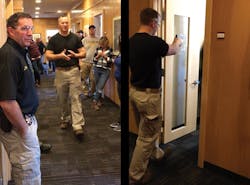Active Shooter Drills: An Eye-Opening Encounter
Most people are wrong. I was.
To be clear, my mettle was tested in a drill conducted by the Linn County (Iowa) Sheriff’s Office, not by a real active shooter. But the experience was truly eye-opening in a way that I couldn’t have predicted.
“Complacency kills,” explains Doug Riniker, a major with the Linn County Sheriff’s Office who led the active shooter training for Stamats Communications, the parent company of BUILDINGS. “[Active shooter training] comes down to taking key points away. We try to drive home situational awareness and being mentally prepared.”
Why Active Shooter Training is Important
The mock shooter in our drill killed all 30 participants in four different offices on “lockdown” in a minute and 20 seconds during the first of three simulations—and he wasn’t in a hurry. Law enforcement officers typically respond to an active shooter within 5-6 minutes, Riniker says.
It really put into perspective just how long 5 minutes or more can feel for help to arrive and how much can go wrong in just a minute and a half.
“It drives home the point on how fast it can happen,” Riniker says. “He was slow and methodical. He took his sweet time and made sure he had a kill shot on every person. It only took 90 seconds for that to happen.”
[Be prepared: Emergency Management Planning]
This stark reality is a crucial aspect of the interactive portion of active shooter training, which involves three scenarios that allow participants to feel on a visceral level the differences between their options for dealing with a violent intruder:
1. Being passive.
During the first step, we essentially practiced a lockdown without barricading the door or trying to escape – essentially relying on the mercy of the “intruder,” Deputy Chad Shover. He moved slowly between each office, targeting each one of us individually with an air-powered handgun that feels surprisingly convincing when it’s pointed right at your face.
2. Run vs. hide.
We made a split-second decision whether to try to keep the intruder out or make a break for it. Running past the “shooter” seemed counterintuitive, but something as simple as becoming a moving target greatly increases the chances of surviving an encounter, Riniker explained at our training.
Surprisingly, we learned that trained law enforcement can only hit a moving target 20 percent of the time.
That number dramatically decreases when it’s a shooter without professional training. This second scenario saw 28 of our 30 participants escape—that’s a 94 percent success rate just from physically moving around.
3. Run vs. fight back.
It is possible to survive contact with an armed intruder, especially by disrupting the physical and mental act of shooting accurately with noise, movement and other distractions, Riniker says.
Throwing a coffee cup, a stapler or keyboard could disrupt the shooter’s concentration just long enough for you to make an escape. During this third training scenario, “fighting back” involved throwing tennis balls at Shover and then making a break for it.
It’s an involuntary response for the shooter to duck or flinch just long enough for you to escape.
What’s Included in Active Shooter Training
Active shooter training typically focuses on the five principles of ALICE:
Alert:
Realize that something bad is happening and prepare to make survival decisions. “There are three human reactions to fear—fight, flight or freeze. Every single person has these,” Riniker notes. “It comes down to how fast you’re going to be able to get out of that freeze mode and do something to increase your own survivability.”
He goes on to say that the more training and preparation you have, in general, the less freeze time you experience.
Watch 360 degree video of our team preparing
“When you walk into a new place, a movie theatre, your work, a restaurant, take 30 seconds to look around and take a mental note of what you could throw at an intruder if you had to. Know where your exits are. If you aren’t on the first floor, look out your window at the ground below and figure out how you would escape out the window. Don’t let it take over your life, just be aware of what’s around you and have a quick plan.”
Lockdown:
If evacuating doesn’t appear to be a safe option, barricade the entry points into your room and prepare to either counter the attacker (with help from other committed people, called SWARM) or flee anyway if the situation changes. There are some instances where barricading a room is the preferred option, especially when it can buy you time.
“He’s looking for easy targets, not to spend 10 minutes in this area if he can go to the other end of the building and find an easier target,” Riniker says. Trainings differentiate between a basic lockdown as part of ALICE vs. a lockdown-only strategy that depends solely on hiding—the latter can be deadly.
Inform:
Communicate your situation to emergency responders with as much information as possible. The law enforcement personnel responding to your building must try to neutralize the threat, and it’s hard to do that if they don’t know what the threat looks like.
“Give us as much initial information as possible,” Riniker says. “‘We have an active shooter, white female, blonde hair, maroon coat, gray hoodie. I saw her shoot at least three people. They’re still shooting.’ That tells us we need to stage EMS and notify hospitals.”
Don’t assume outside people know your building or the area. Sometimes dispatchers are from another county and may not know the big oak tree by the blue building. Law enforcement are not going to now where the HR hallway is. You want to say, “When you come in the front door, turn down the right hallway.”
Answer the dispatcher’s questions as well as you can, but don’t guess if you don’t know.
Eye-opening Lessons from Active Shooter Training
Listen to these startling, real-life examples that destroy your misconceptions of what you should do to survive.
[podcast]
Remember to speak as clearly as possible. You’ll most likely be upset or trying to be quiet or maybe even calling on the run. But you’ll waste precious time if the dispatcher has to interupt you and get you to calm down so they can understand what you're saying. Also, keep in mind that cell phones can make it difficult to hear clearly, especially if you’re outside running from the building.
Don’t be offended if a dispatcher hangs up on you if you don’t have any new information to give them. They are coordinating multiple agencies and may have to hang up to do so.
But you’re not only alerting emergency responders. You need to alert your fellow co-workers and the other people in your building. “Scream with a purpose.” Don’t just scream “shooter.” Give information like, “Shooter in the north end of the building.”
[Mandalay Bay Mass Shooting Anniversary: MGM Sues Victims]
Counter:
Countering a violent intruder isn’t necessarily about fighting—it’s about making it harder to shoot straight. Split-second distractions can buy you valuable time and distance that increases your odds of surviving the encounter.
Evacuate:
Get out of harm’s way. Schools typically have a pre-designated rally point where people should go, but not all buildings need one. The important thing is getting out of the way. “If you can still see the building, you’re probably too close,” Riniker says. Make sure you know every exit out of your building.
Maximize Everyone’s Chance of Survival
There are so many things facilities managers can do to give people in the building a better chance at surviving an encounter with an active shooter. Things that may seem obvious to someone whose job is to know the building inside and out may not be quite as apparent to another person merely works in the building.
Active Shooter Training Information
When you set up an ALICE training in your facility, the coordinator will do a walkthrough of your building to determine where to stage the hands-on part of the exercise. They’re also likely to notice places where you could harden your building or make it easier for people inside to escape. For example:
Unmanned entrances
Do you have a shipping and receiving dock? Is it ever left unlocked? “Any time you have unlocked doors in your building, you’re asking for problems to a certain degree,” Riniker says. Instead of leaving a door unlocked for people making deliveries, consider installing a doorbell or other alert that would let you respond promptly when a delivery arrives.
Glass
You want occupants to be able to break a window if that’s what it takes to escape, but it may be a good idea to harden some of your glass, such as doors in your main entrance with large glass panels. Retrofit window films can be installed over glass to make them bullet-resistant and less likely to shatter. Offices that lock from the inside can help with barricading if that becomes necessary.
[Related: Window Films Offer Clear Safety and Security Solution]
Phones
This is a good place to loop in IT if you have VoIP phones. If you’re dialing 911 from inside the building, do you have to dial 9 first like any other outgoing call? If so, people are likely to forget that during an emergency.
Buy a label maker and put a sticker on every landline reminding people to dial 9 first if they’re calling 911.
This cheap solution could save lives. Alternatively, program (and clearly label) one button on the phone specifically for 911.
Riniker also stresses the need for repeat practice. Skills are perishable, so staying engaged is crucial. Consider scheduling periodic trainings to keep everyone’s skills up to date. A safety committee with leaders of several departments can conduct tabletop exercises for various emergency scenarios, which will help identify weak spots in your planning in between immersive exercises.
[On topic: The Importance of Scheduling Emergency Drills]
“Any time people go through this training, one of the biggest things people take away is saying ‘We need to do more internally’ or ‘We need to emphasize key things to our employees during the monthly staff meeting,’” Riniker says.
“The organization as a whole needs to have a plan in place because if something does happen, you can be out of your building for days, if not weeks. Do we have all of our employee contact information on a local drive that we can remote access so we can contact people who are working from home and tell them what happened? Can IT get us remote access to our computers?”
You don’t always have to invest hours at a time to find ways to improve, adds Riniker. The committee could tackle active shooter preparation one month and a fire in the server room the next month. Actively search out ways to make it easier to survive any incident and get back to normal afterward.
“We’re always willing to come in if you have some ideas that you want to bounce off of us,” Riniker says. “We want to be a resource for people and be an asset. Get ahold of us.”
About the Author
Janelle Penny
Editor-in-Chief at BUILDINGS
Janelle Penny has been with BUILDINGS since 2010. She is a two-time FOLIO: Eddie award winner who aims to deliver practical, actionable content for building owners and facilities professionals.


